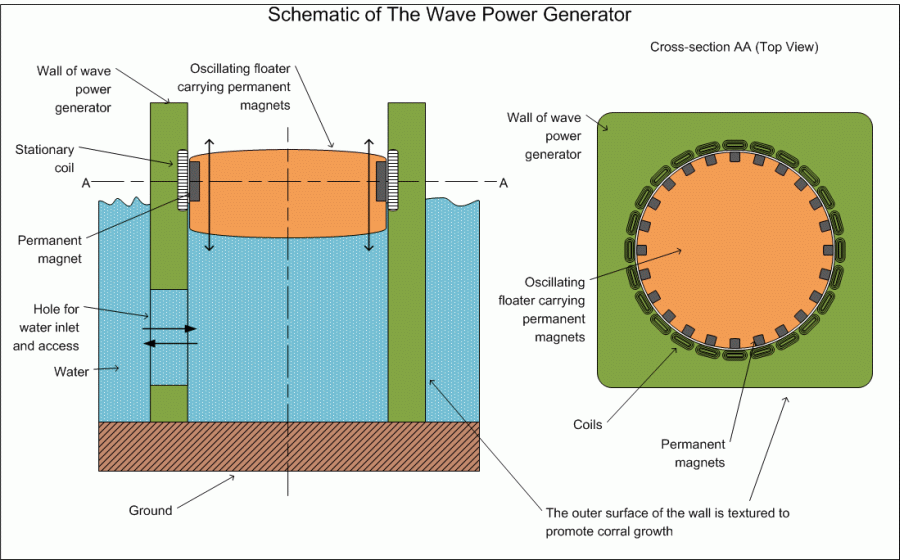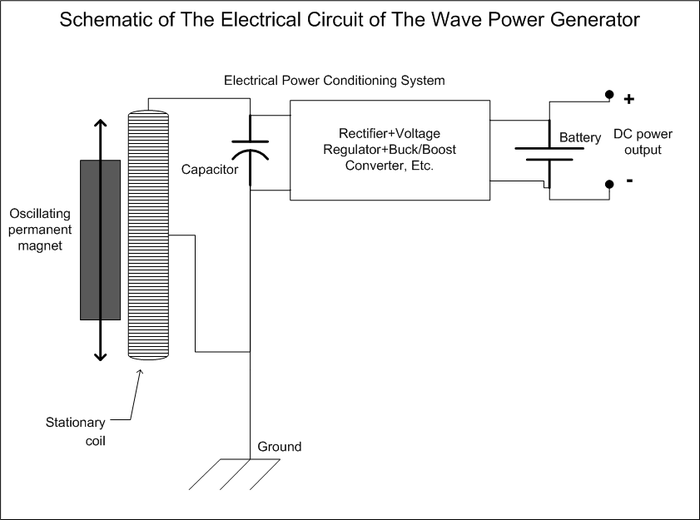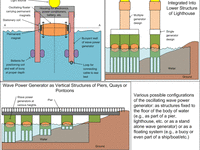This is a simple method of capturing the energy of waves in places where the pressure head is low but kinetic energy of the water is significant. On sea shores, lake shores or banks of rivers, waves are continuously created by the wind all year round but they cannot be harnessed to produce electric power because the pressure of the flow is too low to run turbines. The waves are oscillatory rather than in a steady, unidirectional flow and cannot be easily used to drive a rotary generator. In this method, the up-and-down motion of waves are directly converted to electricity without any motion converters, transmission shafts, couplings or other mechanical devices where energy can be lost, making the process highly efficient. It also employs the simplest, most cost-effective, rugged and durable method, the coil and magnet in a linear generator design.
The apparatus, Figure 1, includes a floating core embedded with permanent magnets (rare-earth magnets for effectiveness) that move up and down with the waves, a housing containing stationary copper coils (encased for protection) and associated electronics for converting the AC to DC for storing in a battery. As the magnets move up and down against the coils, an unsteady current is developed in the coils and a voltage is produced across the coil terminals which is then rectified and smoothed and the current is stored in a battery, see Figure 2. The floating core is made of a buoyant material, such as resilient plastic, with an air filled core so that it moves freely with the waves. The outer walls may be made of concrete or other materials as per cost and environmental conditions. They constrain the movement of the floater to the vertical direction. Other mechanisms such as a shaft guides, grooves or detents may be used to restrict the motion to a desired range. The placement, the length and the width of the magnets and coils must be selected to maximize power generation.
This concept can be used to harness power wherever waves are present and it can be implemented in a variety of forms. It can be fixed to the sea bed as a standalone power generator (a few W to MW power) and connected to a grid onshore or it can be used as the vertical members of structures that stand in the water close to the shore, such as piers, quays, lighthouses, etc. The outer walls can be textured to promote growth of coral and other marine life. Since the device has no exposed turbines or heavy moving parts, there is no danger to marine life. Thus, this device only has a positive impact on its environment. This generator can also be used in deeper waters to power buoys (a few W of power) with the housing chained to the sea floor which actually helps in the operation of the generator as the floater is then free to move against the relatively static coils in the walls.
Voting
-
ABOUT THE ENTRANT
- Name:Philip Panicker
- Type of entry:individual
- Profession:
- Number of times previously entering contest:1
- Philip's favorite design and analysis tools:Pro/Engineer, LabVIEW,
- For managing CAD data Philip's company uses:PTC Windchill
- Philip's hobbies and activities:soccer, motorcycling, reading
- Philip belongs to these online communities:Facebook, LinkedIn
- Philip is inspired by:Nature inspires me. Natural systems are highly efficient in every metric, highly optimized and have multi-purpose functionality. Natural systems use energy very conservatively, they have numerous types of sensors and actuators to interact with their surroundings effectively and efficiently. There is no waste in nature. All products or byproducts have uses for one organism or another.
- Software used for this entry:MS Word, MS Visio
- Patent status:none








